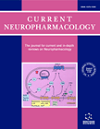- Home
- A-Z Publications
- Current Neuropharmacology
- Previous Issues
- Volume 6, Issue 3, 2008
Current Neuropharmacology - Volume 6, Issue 3, 2008
Volume 6, Issue 3, 2008
-
-
Brain Endothelial Cell-Cell Junctions: How to “Open” the Blood Brain Barrier
More LessAuthors: Svetlana M. Stamatovic, Richard F. Keep and Anuska V. AndjelkovicThe blood-brain barrier (BBB) is a highly specialized structural and biochemical barrier that regulates the entry of blood-borne molecules into brain, and preserves ionic homeostasis within the brain microenvironment. BBB properties are primarily determined by junctional complexes between the cerebral endothelial cells. These complexes are comprised of tight and adherens junctions. Such restrictive angioarchitecture at the BB Read More
-
-
-
The TNF-α System: Functional Aspects in Depression, Narcolepsy and Psychopharmacology
More LessAuthors: Mark Berthold-Losleben and Hubertus HimmerichChanges of the tumor necrosis factor-alpha (TNF-α) system have been shown to be involved in the development of psychiatric disorders and are additionally associated with changes in body weight as well as endocrine and metabolic changes in psychiatric patients. TNF-α might, for example, contribute to the pathogenesis of depression by an activation of the hypothalamo-pituitaryadrenocortical (HPA) axis, an activation of ne Read More
-
-
-
Cellular and Biochemical Actions of Melatonin which Protect Against Free Radicals: Role in Neurodegenerative Disorders
More LessMolecular oxygen is toxic for anaerobic organisms but it is also obvious that oxygen is poisonous to aerobic organisms as well, since oxygen plays an essential role for inducing molecular damage. Molecular oxygen is a triplet radical in its ground-stage (.O-O.) and has two unpaired electrons that can undergoes consecutive reductions of one electron and generates other more reactive forms of oxygen known as free radicals Read More
-
-
-
Assessing the Neuronal Serotonergic Target-based Antidepressant Stratagem: Impact of In Vivo Interaction Studies and Knockout Models
More LessAuthors: R. Rajkumar and R. MaheshDepression remains a challenge in the field of affective neuroscience, despite a steady research progress. Six out of nine basic antidepressant mechanisms rely on serotonin neurotransmitter system. Preclinical studies have demonstrated the significance of serotonin receptors (5-HT1-3,6,7), its signal transduction pathways and classical down stream targets (including neurotrophins, neurokinins, other peptides and their Read More
-
-
-
Functional Neuroanatomy of the Noradrenergic Locus Coeruleus: Its Roles in the Regulation of Arousal and Autonomic Function Part I: Principles of Functional Organisation
More LessAuthors: E. R. Samuels and E. SzabadiThe locus coeruleus (LC) is the major noradrenergic nucleus of the brain, giving rise to fibres innervating extensive areas throughout the neuraxis. Recent advances in neuroscience have resulted in the unravelling of the neuronal circuits controlling a number of physiological functions in which the LC plays a central role. Two such functions are the regulation of arousal and autonomic activity, which are inseparably linked largely Read More
-
-
-
Functional Neuroanatomy of the Noradrenergic Locus Coeruleus: Its Roles in the Regulation of Arousal and Autonomic Function Part II: Physiological and Pharmacological Manipulations and Pathological Alterations of Locus Coeruleus Activity in Humans
More LessAuthors: E. R. Samuels and E. SzabadiThe locus coeruleus (LC), the major noradrenergic nucleus of the brain, gives rise to fibres innervating most structures of the neuraxis. Recent advances in neuroscience have helped to unravel the neuronal circuitry controlling a number of physiological functions in which the LC plays a central role. Two such functions are the regulation of arousal and autonomic activity, which are inseparably linked largely via the involve Read More
-
-
-
Role of the Central Cholinergic System in the Therapeutics of Schizophrenia
More LessThe therapeutic agents currently used to treat schizophrenia effectively improve psychotic symptoms; however, they are limited by adverse effects and poor efficacy when negative symptoms of the illness and cognitive dysfunction are considered. While optimal pharmacotherapy would directly target the neuropathology of schizophrenia neither the underlying neurobiological substrates of the behavioral symptoms nor the cognit Read More
-
Volumes & issues
-
Volume 23 (2025)
-
Volume 22 (2024)
-
Volume 21 (2023)
-
Volume 20 (2022)
-
Volume 19 (2021)
-
Volume 18 (2020)
-
Volume 17 (2019)
-
Volume 16 (2018)
-
Volume 15 (2017)
-
Volume 14 (2016)
-
Volume 13 (2015)
-
Volume 12 (2014)
-
Volume 11 (2013)
-
Volume 10 (2012)
-
Volume 9 (2011)
-
Volume 8 (2010)
-
Volume 7 (2009)
-
Volume 6 (2008)
-
Volume 5 (2007)
-
Volume 4 (2006)
-
Volume 3 (2005)
-
Volume 2 (2004)
-
Volume 1 (2003)
Most Read This Month
Article
content/journals/cn
Journal
10
5
false
en


